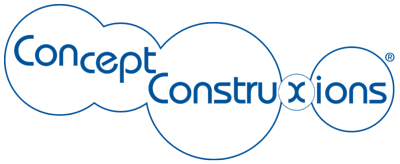
…is a transdisciplinary pattern recognition system that helps learners construct concepts and acquire academic or technical language in social, collaborative ways
We all want to speak and write with more confidence, and communicate our expertise using appropriate language. As workplaces and communities grow more complex, we need to feel connected and heard.
But all too often, academic or technical language is weaponized to exclude those who don’t “already” understand it. Experts write and talk to each other in ways that alienate those who aren’t part of the club.
So we wondered what would happen if we turned that exclusion on its head: What if we could build a system that invites people into a discipline, and helps them make conceptual connections across disciplines?
Concept Construxions is our patented solution.
The hands-on version of the system is depicted in our Video Series It’s a wonderful tool for increasing active engagement, academic discourse, and conceptual understanding. It’s also a nice complement to screen time!
See how we employed CAST’s Universal Design for Learning (UDL) Guidelines.
Concept Cards
Concept Cards are the hands-on and on-screen manipulatives of the system. Subject sets represent a collection of words, symbols, abbreviations, values and formulas used to support knowledge building and disciplinary literacy. Literature Concepts, shown in the video, is a single Subject Set useful in multiple secondary and post- secondary grade levels.

The Shape System
The same shape system cross-cuts all disciplines, thereby offering an infrastructure for academic language learning. Students move from class to class or setting to setting, and the system provides an anchor as they build understanding.
The Color System
Color maintains consistency from year to year, supporting long-term conceptual understanding in major subject areas. For example, Concept Cards such as “equation” and “expression” remain the same from middle through high school, however the breadth and depth of each increases greatly as the math becomes more challenging. Students learn to negotiate meaning over time, and to use the domain-specific vocabulary with ease.
Learning Contexts
On the back of each Concept Card is a space to note the context in which the class uses a given term or phrase. These notes can be archived right on the card and kept for future reference. Concepts should be revisited from context to context, allowing students to deepen their understanding and build background knowledge. Click image below to flip front to back.

For more detailed information about the research and development behind Concept Construxions, view the screencast below.
Concept Construxions is a patented System and Method for Educational Instruction.
US Patent #7,896,651

